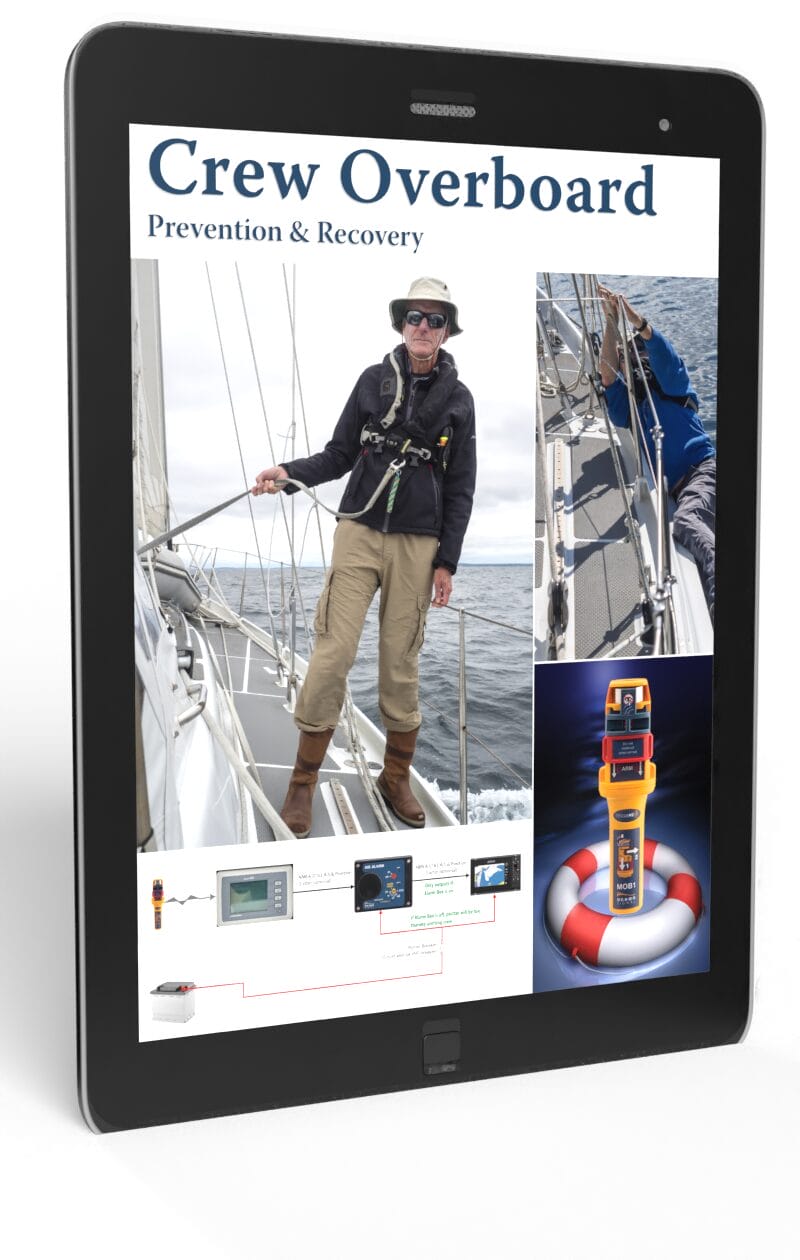Jackline Usage Thoughts
10 CommentsReading Time: 6 minutes
More Articles From Online Book: Crew Overboard Prevention & Recovery:
- We Should Focus On Staying Aboard, Not Recovery
- The Risks of Falling Overboard at Sea
- The Real Reason to Use a Harness and Tether
- Staying Attached To The Boat
- The Risks Of Sidedeck Jacklines Quantified
- Flawed Jackline Systems Revisited
- Better Jacklines
- Banishing Sidedeck Jacklines Forever
- Limiting COB Drag Risk On A Smaller Boat
- Jackline Usage Thoughts
- Jacklines: Materials, Fabrication and Installation
- The Right Tethers To Keep Us Aboard—Part 1, A Mix
- The Right Tethers To Keep Us Aboard—Part 2, Construction and Hardware
- Harnesses and Lifejackets and How to Use Them
- Crew Overboard Prevention—Use of Climbing Harnesses
- Should We Wear Lifejackets or Harnesses, Both, Neither?
- Which Lifejacket Auto-Inflator Should We Select?
- Crew Overboard Recovery, Is The Quick Stop Bogus?
- Crew Overboard Recovery—Our Replacement For Quick Stop

Thanks for another nice pragmatic article John. I’ve always used “one hand for the boat” in the opposite sense to how you’ve used it in this article. I.e. in the sense US boating uses it here:
https://youtube.com/shorts/izCaEIpUqUQ?si=BAtZDBAta3lqEYwg
This caused confusion for me when reading your guidelines. Maybe others will also be confused?
Hi Quinton,
I guess me and that guy will have to disagree. At least as I remember it, the quote refers to one hand to hold on (for yourself) and one hand for the ship (the one you are using for the task at hand). I believe this goes back to the days of going aloft to work, and is how I have heard it used for at least 60 years.
I have read and very much appreciate everything you have written about jacklines and COB recovery. I was particularly glad to see that you are revisiting these issues with your J/109 since we face some similar challenges on our J/99, so I’m now reading closely your detailed write up of how you’ve set up that boat. I do have one question about your assessment of the danger of trimming the jib from the low side winch: why do you not cross-sheet the jib to remain on the high side when short or single handed? I would still want to be clipped in, but find this a much safer practice.
Hi Stuart,
Good point. However, while J109 race crews do cross sheet, the boat is not well set up for it, particularly the winch angles. Also, I don’t really like having a sheet across the cockpit to climb back and forth over.
Knee pads. They look good! Just for comfort/injuries, or do you consider them a safety item too, because the encourage you to kneel instead of stand when you should?
Cross sheeting. Just last week added a home-made winch feeder block (good lathe practice) so that I could re-direct a few lines, eliminating specific winch conflicts that occurred during a few specific operations. Not a big deal, but slicker than the work-arounds I had been using. Pretty easy (if you buy instead of machine), not expensive, and it does not add clutter. However, I agree that cross sheeting can create a cat’s cradle. The only times I have done it were in very strong conditions when it gave me improved quick tuning or release, something that can matter on a multihull.
I did a survey of trimaran owners once, curious as to what the most common COB situations might be. Nearly 50% related to racers coming in off the wing nets during tacks and sliding off the back. Also when going out on the leeward net, since it slopes, is wet, and can be slick as grease even in deck shoes (I ALWAYS have a line or something in my hand when crossing nets, even if clipped on). They typically lack lifelines, other than a sternrail. I added a lifeline across the back, since that is the most common trajectory.
I’ve always feared just stupidly tripping over my own feet and going off the back. Not likely, but it’s always in my head.
Hi Drew,
Knee pads: comfort, I was a runner for decades, and a sailmaker before that, so the old knees are not what they once were. That said, they do encourage me to kneel, which is good too.
Crosssheeting: As you say, adds clutter and particularly bad for me in that I have all my nav gear under the dodger, as well as control lines, so I’m constantly back and forth over the area.
Also a really good point about the nets and transiting them. Just shows that each of us must really think about the dangers inherent in our own boats.
Hi John and Drew,
Can you share what brand of knee pads give the best chance of staying in place when moving. Mine are old and fine for stationary jobs, but as soon as I start moving they get out of place.
Thanks, Dick
Hi Dick,
I use the ones from Spinnlock and find they work well, but I bet Drew has done a study and knows more.
Would crossing the sheets make sense as part of this? Then you are winching on the high side.
Hi Stanley,
Yes, can be a good plan, But see my answers to Drew and Stuart further up the thread.